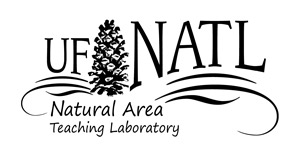| UF Academic Use | Public Use | Family Fun and K-12 Education |

Nature Trail Development
Funding: The original proposal (1993) to establish NATL envisioned a system of nature trails through the three upland ecosystems in the public portion of NATL. For more than a decade, no nature trails were established because of a lack of funds and the need to tend to more pressing aspects of NATL's development. In 2005, Student Government and the Administration agreed to use $500,000 from the student-generated Capital Improvement Trust Fund for an Environmental Stewardship project to improve the University's 20-odd conservation areas. The Natural Area Advisory Committee [NAAC] asked for money from this project to establish four self-guided nature trails in the NATL-west Conservation Area--namely, the three long-desired upland trails plus a wetlands trail for SEEP, a stormwater retention basin re-contoured in 1998. In the spring of 2006 NAAC was awarded $100,000 for these trails with the understanding that the SEEP Trail would include a boardwalk. When it became apparent that the cost of the boardwalk and six contractor-built, trail-head kiosks would greatly exceed the amount awarded, additional funds were sought and received from several sources. Furthermore, the Florida Museum of Natural History agreed to help build the kiosks, with NAAC-supplied materials, saving NAAC about $6,000. Detailed plans facilitated the Museum's participation.
Trail layout: It was anticipated that a majority of those using the trails would be visitors to UF's Cultural Plaza and that the Florida Museum of Natural History's Outdoor Nature Programs would use NATL much more than in the past. Consequently the layout of the trails was optimized for access to the trail-heads from the Cultural Plaza and from the adjacent Natural Area Park. The last link in completing the trail layout was an access trail from the Cultural Plaza to the trailheads for the Upland Pine and Old Field Nature Trails. This trail was developed by UF's Physical Plant in cooperation with the Cultural Plaza Advisory Committee. The Natural Area Advisory Committee designed and funded the access trail's wayfinding signs, including a directional sign at the origin of the trail and a 3x2 ft sign highlighting the ecosystems traversed by the four nature trails--installed just north of where the trail crosses the Florida Museum of Natural History's service drive. Installation of these signs was completed in March 2010.
Initial content development: Six graduate students in Susan Jacobson's Fall 2006 class on Environmental Interpretation undertook the development of the explanatory panels for the six nature trail kiosks, for the stand-alone panels along the SEEP Nature Trail, and for the west side of the Natural Area Park kiosk. One trio (Josiah Townsend, Krystal Noiseux, Jeffrey Anderson) worked on the panels for the three upland trails, and the other (Kristine Hoffmann, Fred Fisher, Dara Wald) attended to the panels for the NAP and SEEP kiosks and for the signs along the SEEP Trail. To continue their design work during the Spring Semester of 2007, the two trios applied for and received $500 minigrants.
Personnel: Mark Clark, Advisor to the Wetlands Club, was in charge of the development of the SEEP Trail, and T. J. Walker, NAAC Administrative Assistant, saw to the development of the three upland trails. They were greatly assisted by NATL's Graduate Teaching Assistants Kevin Ratkus, Julian Resasco, and Jason Martin, by Undergraduate Assistants Tim Ruscello and Marissa Streifel, by members of the Wetlands Club, and by others who generously volunteered their time and talents.


